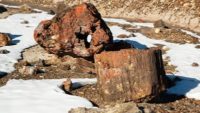Two of the remotest places ever visited by humans are the moon and the deepest part of the ocean. Earth’s lowest point is called the “Challenger Deep,” a depression inside the southern end of the Mariana Trench—the deepest point in the western Pacific Ocean, located in the territorial waters of the Federated States of Micronesia, east of the Mariana Islands. Kelly Walsh, th… More… …read more Source: icr.org
Surprising catastrophism in sediments for uniformitarians; is it consistent with the Flood? …read more Source: creation.com
No! That was early during Noah’s Flood and continents still existed …read more Source: creation.com
Folded, bent and deformed rock layers across the globe testify to catastrophe on an unimaginable scale. …read more Source: creation.com
The growth rings in Paleozoic corals are often used to support the idea that the earth is very old, but the argument was flawed from the beginning. …read more Source: creation.com
In order for the bizarre theory of evolution to be validated, evolutionists must show how inorganic non-life organized itself into carbon-based (organic) life. They also must show how major transitions in animals occurred, including how fish became the first tetrapods. This means fish fins would need to slowly turn into feet and legs. As one secular journal said, “The evolution of fishes into tetrapods—four-legged vertebrates of which… More… …read more Source: icr.org
Did octopus fossil ink really survive millions of years? …read more Source: creation.com
By Ken Ham When we think rainforests, we think tropical, sunshine (and lots of it), and frequent rains. We don’t think of frigid winds, bone-chilling temperatures, and icy seawaters. But that’s where the remains of a fossil rainforest were found—on the continent known for penguins instead of tropical parrots: Antarctica! A new study found tropical fossils, similar to the current flora in New Zealand’s South Island, in Cretaceous layers. Now, this isn’t the first time the remains of seemingly out-of-place organisms have been found on the southernmost continent. But a new study found tropical fossils, similar to the current flora [More]
While searching for a missing plane on the ocean floor, scientists made an interesting geological discovery. On March 8, 2014, Malaysia Airlines flight MH330 disappeared with all 239 people on board somewhere over the southern Indian Ocean. So far, no pieces of the plane have ever been found on the ocean floor. From 2014 to 2016, three vessels collected detailed sonar images over a large piece of the Indian Ocean whi… More… …read more Source: icr.org
Scientists recently discovered evidence that large theropods were possibly guilty of cannibalism.1 The new study, published in PLOS ONE, examined over 2,300 bones from the Mygatt-Moore Quarry in western Colorado.1 It was led by Stephanie Drumheller, from the Department of Earth and Planetary Sciences, the University of Tennessee, Knoxville, and several colleagues. The scientists determined that about … More… …read more Source: icr.org
A new analysis of thousands of deep earthquakes has revealed several large structures at the base of the mantle.1 Known as ultra-low velocity zones, these structures may give us better insight into the origins of hot spots which produced the Hawaiian Islands during the Flood year. Doyeon Kim from the University of Maryland and his colleagues analyzed over 6,000 shear (S-waves) waves from earthquakes deeper than … More… …read more Source: icr.org
Scientists from China, Sweden, and Australia have discovered what they claim is the oldest known parasite, publishing their results in Nature Communications.1 The evidence comes from small tube-shaped objects attached to the shells of the host brachiopods.2 Scientists speculate that these tubes contained some sort of parasitic worm. Parasites are “nutritionally dependent upon the host for at lea… More… …read more Source: icr.org
In 2017, a large dinosaur was discovered washed out to sea,1 similar to the dinosaur bone found 70 miles off Norway’s coast.2 Only this one was partially intact, nearly perfectly preserved, and still contained its last meal fossilized inside its gut.1 Recently, a group led by paleontologists from the Royal Tyrrell Museum of Palaeontology examined the stomach contents of the dinosaur and reported their findin… More… …read more Source: icr.org
By Ken Ham If you were hunting for dinosaur footprints, it probably wouldn’t occur to you to look up—but that’s exactly where a team of researchers discovered a trackway of the footprints of a titanosaur (long-necked sauropod). In Southern France, researchers were crawling through a labyrinth of cave passages and discovered the prints, 1,640 feet underground. The researchers discovered 38 tracks, some of which were four feet long (now that’s one big dinosaur!), likely made by three of the giant creatures. The researchers discovered 38 tracks, some of which were four feet long (now that’s one big dinosaur!), likely made [More]
The very first tapejarid pterosaur identified in the United Kingdom was recently found on the Isle of Wight along the southern coast of England.1 But the discovery also raises some questions that are uncomfortable for uniformitarian scientists. Tapejarids are extinct flying reptiles that have “elaborate soft tissue head crests” and a few other anatomical differences from other pterosaurs.1 More… …read more Source: icr.org
Can they form in moving water, consistent with Noah’s Flood? …read more Source: creation.com
The Scottish island of Kerrera has produced the earliest known bug in the fossil record, a millipede.1 It was found in Silurian System rocks recently claimed by secular scientists to be 425 million years old.1 Unexplainably, their millipede fossil just seemed to show up, fully-formed as a completely functioning “creeping thing.” This discovery also caused some consternation with the uniformitarian … More… …read more Source: icr.org
A massive canyon rivalling Grand Canyon has been discovered beneath the ice on Greenland, and uniformitarian scientists are explaining it as a consequence of flooding.1 We couldn’t agree more. Greenland canyon is as deep as Grand Canyon and is about 450 miles long.2 It is too old to be a result of the Ice Age, so the mystery of how it could have formed has baffled uniformitarian geologists. … More… …read more Source: icr.org
A new study published in Earth and Planetary Science Letters has determined that P?h?honu volcano is the world’s largest by volume and the hottest.1 Found almost 700 miles northwest of Hawai’i, P?h?honu volcano is almost completely submerged beneath the Pacific Ocean.2 Only two small, rocky remnants stick up to about 170 feet above the surface, exposing only six acres in area.1 More… …read more Source: icr.org
By Ken Ham We have an incredible fossil here at the Creation Museum that guests can see in one of our excellent exhibits. It’s a fossil of a fish halfway through swallowing another fish, which was supposed to be its dinner! This fossil clearly points to catastrophic burial—the fish didn’t even have time to finish swallowing its prey before it was rapidly buried. Well, a fossil discovered off the coast of England tells a similar story. A squid-like creature, called a belemnoid, with “ten arms covered with hooks,” was fossilized with a fish that had been viciously killed, presumably for [More]
How could T. rex be buried with sharks in the same rock formation? Read More
A new study published in the journal Gondwana Research has identified a rather out-of-place bone from a theropod dinosaur called an elaphrosaur that apparently didn’t eat meat.1 In fact, it was toothless. Adding to the mystery, it was found in rocks thought by secular scientists to be 40 million years too young.2 Furthermore, the dinosaur was found in a location that is claimed to have been close to t… More… …read more Source: icr.org
The beginning of modern-style plate tectonics is another unsolved mystery in uniformitarian geology. No secular geologist seems to have a good answer. Some have even speculated that massive meteorites or large mantle plumes could have started the plates moving, but there is little physical evidence to support either.1 Recently, another attempt was made to solve this mystery. A new study published in Science AdvancesMore… …read more Source: icr.org
How quickly did they form? …read more Source: creation.com
By Dr. Andrew A. Snelling Forty years later, Mount St. Helens still teaches us lessons about the powerful forces the Creator uses to shape the earth. …read more Source: AIG Daily
A newly published analysis of four fossil molar teeth from a monkey dug up along the left bank of the Yuruá River in the Peruvian Amazon is causing a great deal of evolutionary confusion.1 The problem is that this particular type of monkey has only been found previously in rocks of the same strata in North Africa. While this new finding causes grief for evolution, it vindicates geological data from Genesis Flood research conduct… More… …read more Source: icr.org
A new study published in Proceedings of the Geologists’ Association has found what is claimed to be the oldest recorded attack by a squid-like creature.1 Uniformitarian scientists are struggling to explain to origin of this unique fossil, because both the squid-like animal and the prey were preserved in a life-like entanglement. The 24-inch fossil includes a squid-like animal called a belemnoid wi… More… …read more Source: icr.org


















![It’s Time to Go Home [Live] It’s Time to Go Home [Live]](http://img.youtube.com/vi/OqNs3fNsHuY/0.jpg)


























